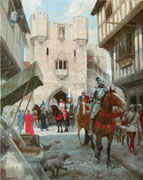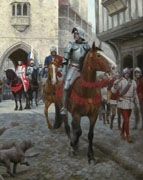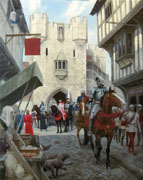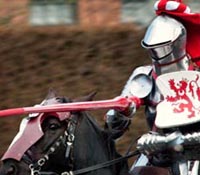When I planned
this painting diary, I optimistically thought that 4 weeks would
allow enough time to see the painting completed. When will I
learn! - my paintings always take longer than planned, which
is probably why I often end up working evenings and weekends;
something that has become necessary lately. I can usually complete
a gouache painting - the sort I do for Osprey - in a week or
so, but oils take so much longer. In this case it is the amount
of detail that is proving time consuming - I can easily spend
a whole day working away on what is a comparatively small area.
This week
I managed to get the painting looking almost finished. It's
only when you look closely that you see where more work is needed.
If you can bear with me for another seven days, I will be able
to reveal the finished picture next Friday.

Click
image to enlarge |
Week 4 saw
me start with the soldiers on the right - the Flemish hand gunners
or 'blak and smoky sort of Gunners Flemyngys' as they were referred
to at the time. Obviously, I have tried to give them the grubby
look that the chronicler commented on. I have also made use
of some very recent research by Dave Key into methods of identifying
soldiers on campaign. He has found many references to 'bends'
of cloth being worn by all ranks, in the livery colours of their
commander and bearing his badge. In heraldic terms, the bend
is a diagonal stripe and this, together with other evidence,
has lead him to the conclusion that sashes were worn alongside
(or sometimes, along with) livery jackets.
Having read
Dave's notes, I have been convinced enough to equip Edward's
Flemish mercenaries with 'bends' in the Yorkist livery colours
of murrey and blue with the badge of a white rose - so much
quicker and cheaper to issue than complete jackets, something
that must have been important to an exiled King.

Click
image to enlarge |
Moving onto
the foreground rider, I concentrate on getting his armour looking
realistic. I enjoy painting armour - which is just as well I
suppose - the metal surface allowing so much variety of colour
and tone. Polished metal reflects the colours around it, so
upper surfaces tend to mirror the sky, whilst the sides pick
up whatever else surrounds the figure. Other factors, such as
the degree of polish or a covering of rust all help to vary
the appearance of helmets and armour, and, with this figure,
being overshadowed by the tall buildings provides a further
challenge. What you see is the result of many hours of adjusting
- adding a darker tone here, a bit more blue there - until I'm
happy with the final effect. As with all drawing and painting,
you can't beat observation from life and seeing armour worn
in the field by re-enactors has helped me enormously. Even if
the style is not correct, the way the plates move in relation
to each other and how the curved surfaces appear outside are
all things you can't see in a museum.

Click
image to enlarge |
The style
of armour I have chosen to show is typical of that which was
worn in England during this period, but it is a style that only
survives on tomb effigies. The small amount of 15th century
armour that remains can be categorised as either German, with
it's gothic spikes and fluting, or Italian, a much rounder style.
While pure Italian armour appears on some English effigies,
demonstrating the Italian export market, most combine elements
from both styles. My reconstructions are based on a study of
tomb effigies, using my knowledge of real armour to translate
what the sculptor has shown into something that would work if
made in steel. Speaking to modern armourers has also helped
me differentiate between what is possible and when the medieval
sculptor has used his artistic licence.
The rest
of the week is spent working up the whole painting, and as I
have previously discussed most of the individual areas I will
let the pictures speak for themselves. As well as showing the
completed painting in my final update next Friday, I will include
some close up photos of details.
Return
to Introduction
Back
to Week 3 - Forward to Week
5






